Kai Tian
MARS2 2025 Challenge on Multimodal Reasoning: Datasets, Methods, Results, Discussion, and Outlook
Sep 17, 2025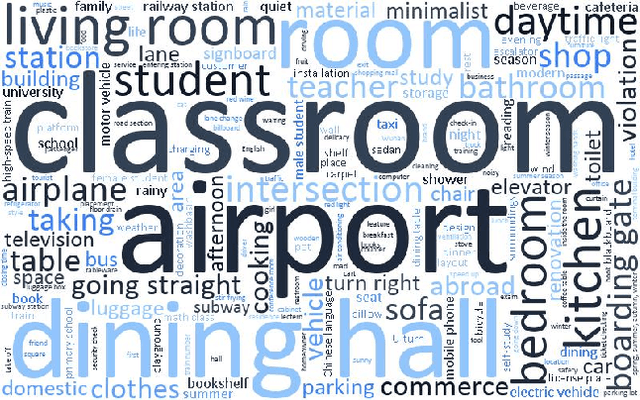
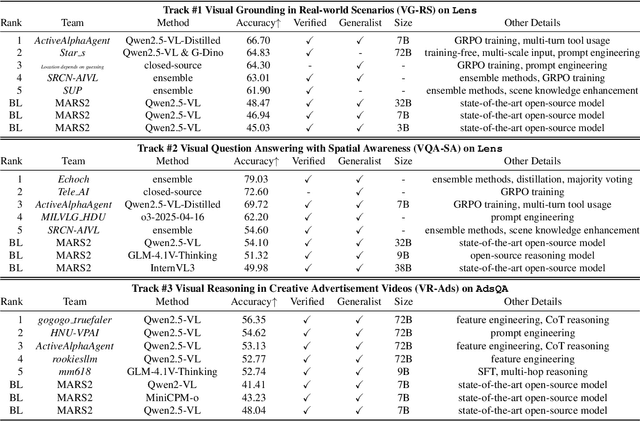
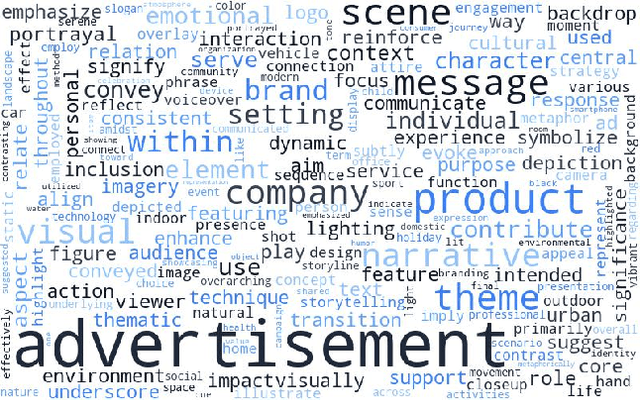

Abstract:This paper reviews the MARS2 2025 Challenge on Multimodal Reasoning. We aim to bring together different approaches in multimodal machine learning and LLMs via a large benchmark. We hope it better allows researchers to follow the state-of-the-art in this very dynamic area. Meanwhile, a growing number of testbeds have boosted the evolution of general-purpose large language models. Thus, this year's MARS2 focuses on real-world and specialized scenarios to broaden the multimodal reasoning applications of MLLMs. Our organizing team released two tailored datasets Lens and AdsQA as test sets, which support general reasoning in 12 daily scenarios and domain-specific reasoning in advertisement videos, respectively. We evaluated 40+ baselines that include both generalist MLLMs and task-specific models, and opened up three competition tracks, i.e., Visual Grounding in Real-world Scenarios (VG-RS), Visual Question Answering with Spatial Awareness (VQA-SA), and Visual Reasoning in Creative Advertisement Videos (VR-Ads). Finally, 76 teams from the renowned academic and industrial institutions have registered and 40+ valid submissions (out of 1200+) have been included in our ranking lists. Our datasets, code sets (40+ baselines and 15+ participants' methods), and rankings are publicly available on the MARS2 workshop website and our GitHub organization page https://github.com/mars2workshop/, where our updates and announcements of upcoming events will be continuously provided.
A Survey of Reinforcement Learning for Large Reasoning Models
Sep 10, 2025Abstract:In this paper, we survey recent advances in Reinforcement Learning (RL) for reasoning with Large Language Models (LLMs). RL has achieved remarkable success in advancing the frontier of LLM capabilities, particularly in addressing complex logical tasks such as mathematics and coding. As a result, RL has emerged as a foundational methodology for transforming LLMs into LRMs. With the rapid progress of the field, further scaling of RL for LRMs now faces foundational challenges not only in computational resources but also in algorithm design, training data, and infrastructure. To this end, it is timely to revisit the development of this domain, reassess its trajectory, and explore strategies to enhance the scalability of RL toward Artificial SuperIntelligence (ASI). In particular, we examine research applying RL to LLMs and LRMs for reasoning abilities, especially since the release of DeepSeek-R1, including foundational components, core problems, training resources, and downstream applications, to identify future opportunities and directions for this rapidly evolving area. We hope this review will promote future research on RL for broader reasoning models. Github: https://github.com/TsinghuaC3I/Awesome-RL-for-LRMs
AdsQA: Towards Advertisement Video Understanding
Sep 10, 2025Abstract:Large language models (LLMs) have taken a great step towards AGI. Meanwhile, an increasing number of domain-specific problems such as math and programming boost these general-purpose models to continuously evolve via learning deeper expertise. Now is thus the time further to extend the diversity of specialized applications for knowledgeable LLMs, though collecting high quality data with unexpected and informative tasks is challenging. In this paper, we propose to use advertisement (ad) videos as a challenging test-bed to probe the ability of LLMs in perceiving beyond the objective physical content of common visual domain. Our motivation is to take full advantage of the clue-rich and information-dense ad videos' traits, e.g., marketing logic, persuasive strategies, and audience engagement. Our contribution is three-fold: (1) To our knowledge, this is the first attempt to use ad videos with well-designed tasks to evaluate LLMs. We contribute AdsQA, a challenging ad Video QA benchmark derived from 1,544 ad videos with 10,962 clips, totaling 22.7 hours, providing 5 challenging tasks. (2) We propose ReAd-R, a Deepseek-R1 styled RL model that reflects on questions, and generates answers via reward-driven optimization. (3) We benchmark 14 top-tier LLMs on AdsQA, and our \texttt{ReAd-R}~achieves the state-of-the-art outperforming strong competitors equipped with long-chain reasoning capabilities by a clear margin.
ReviewRL: Towards Automated Scientific Review with RL
Aug 14, 2025Abstract:Peer review is essential for scientific progress but faces growing challenges due to increasing submission volumes and reviewer fatigue. Existing automated review approaches struggle with factual accuracy, rating consistency, and analytical depth, often generating superficial or generic feedback lacking the insights characteristic of high-quality human reviews. We introduce ReviewRL, a reinforcement learning framework for generating comprehensive and factually grounded scientific paper reviews. Our approach combines: (1) an ArXiv-MCP retrieval-augmented context generation pipeline that incorporates relevant scientific literature, (2) supervised fine-tuning that establishes foundational reviewing capabilities, and (3) a reinforcement learning procedure with a composite reward function that jointly enhances review quality and rating accuracy. Experiments on ICLR 2025 papers demonstrate that ReviewRL significantly outperforms existing methods across both rule-based metrics and model-based quality assessments. ReviewRL establishes a foundational framework for RL-driven automatic critique generation in scientific discovery, demonstrating promising potential for future development in this domain. The implementation of ReviewRL will be released at GitHub.
Code-Vision: Evaluating Multimodal LLMs Logic Understanding and Code Generation Capabilities
Feb 17, 2025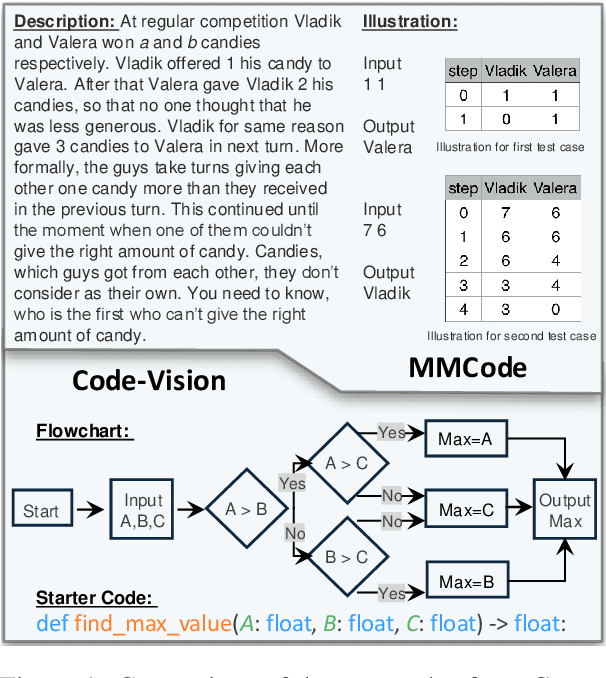

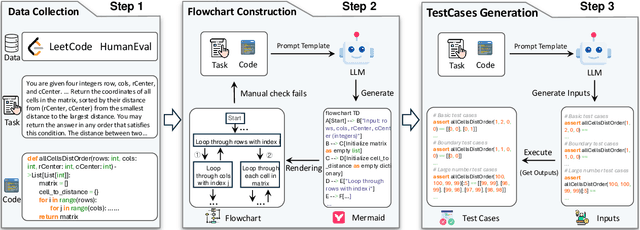
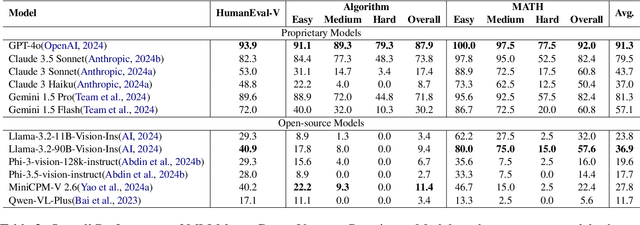
Abstract:This paper introduces Code-Vision, a benchmark designed to evaluate the logical understanding and code generation capabilities of Multimodal Large Language Models (MLLMs). It challenges MLLMs to generate a correct program that fulfills specific functionality requirements based on a given flowchart, which visually represents the desired algorithm or process. Code-Vision comprises three subsets: HumanEval-V, Algorithm, and MATH, which evaluate MLLMs' coding abilities across basic programming, algorithmic, and mathematical problem-solving domains. Our experiments evaluate 12 MLLMs on Code-Vision. Experimental results demonstrate that there is a large performance difference between proprietary and open-source models. On Hard problems, GPT-4o can achieve 79.3% pass@1, but the best open-source model only achieves 15%. Further experiments reveal that Code-Vision can pose unique challenges compared to other multimodal reasoning benchmarks MMCode and MathVista. We also explore the reason for the poor performance of the open-source models. All data and codes are available at https://github.com/wanghanbinpanda/CodeVision.
Generative Regression Based Watch Time Prediction for Video Recommendation: Model and Performance
Dec 28, 2024



Abstract:Watch time prediction (WTP) has emerged as a pivotal task in short video recommendation systems, designed to encapsulate user interests. Predicting users' watch times on videos often encounters challenges, including wide value ranges and imbalanced data distributions, which can lead to significant bias when directly regressing watch time. Recent studies have tried to tackle these issues by converting the continuous watch time estimation into an ordinal classification task. While these methods are somewhat effective, they exhibit notable limitations. Inspired by language modeling, we propose a novel Generative Regression (GR) paradigm for WTP based on sequence generation. This approach employs structural discretization to enable the lossless reconstruction of original values while maintaining prediction fidelity. By formulating the prediction problem as a numerical-to-sequence mapping, and with meticulously designed vocabulary and label encodings, each watch time is transformed into a sequence of tokens. To expedite model training, we introduce the curriculum learning with an embedding mixup strategy which can mitigate training-and-inference inconsistency associated with teacher forcing. We evaluate our method against state-of-the-art approaches on four public datasets and one industrial dataset. We also perform online A/B testing on Kuaishou, a leading video app with about 400 million DAUs, to demonstrate the real-world efficacy of our method. The results conclusively show that GR outperforms existing techniques significantly. Furthermore, we successfully apply GR to another regression task in recommendation systems, i.e., Lifetime Value (LTV) prediction, which highlights its potential as a novel and effective solution to general regression challenges.
Large Language Models as Biomedical Hypothesis Generators: A Comprehensive Evaluation
Jul 12, 2024



Abstract:The rapid growth of biomedical knowledge has outpaced our ability to efficiently extract insights and generate novel hypotheses. Large language models (LLMs) have emerged as a promising tool to revolutionize knowledge interaction and potentially accelerate biomedical discovery. In this paper, we present a comprehensive evaluation of LLMs as biomedical hypothesis generators. We construct a dataset of background-hypothesis pairs from biomedical literature, carefully partitioned into training, seen, and unseen test sets based on publication date to mitigate data contamination. Using this dataset, we assess the hypothesis generation capabilities of top-tier instructed models in zero-shot, few-shot, and fine-tuning settings. To enhance the exploration of uncertainty, a crucial aspect of scientific discovery, we incorporate tool use and multi-agent interactions in our evaluation framework. Furthermore, we propose four novel metrics grounded in extensive literature review to evaluate the quality of generated hypotheses, considering both LLM-based and human assessments. Our experiments yield two key findings: 1) LLMs can generate novel and validated hypotheses, even when tested on literature unseen during training, and 2) Increasing uncertainty through multi-agent interactions and tool use can facilitate diverse candidate generation and improve zero-shot hypothesis generation performance. However, we also observe that the integration of additional knowledge through few-shot learning and tool use may not always lead to performance gains, highlighting the need for careful consideration of the type and scope of external knowledge incorporated. These findings underscore the potential of LLMs as powerful aids in biomedical hypothesis generation and provide valuable insights to guide further research in this area.
Intuitive Fine-Tuning: Towards Unifying SFT and RLHF into a Single Process
May 20, 2024



Abstract:Supervised Fine-Tuning (SFT) and Reinforcement Learning from Human Feedback (RLHF) are two fundamental processes for enhancing the capabilities of Language Models (LMs) post pre-training, aligning them better with human preferences. Although SFT advances in training efficiency, RLHF delivers better alignment, thus they are often combined. However, common practices simply apply them sequentially without unifying their optimization targets, resulting in a trade-off between fitting different objectives, and ignoring the opportunities to bridge the paradigm gap and take the strength from both. To obtain a unified understanding, we interpret SFT and RLHF using two sub-processes -- Preference Estimation and Transition Optimization -- defined at token level within the Markov Decision Process (MDP) framework. This modeling shows that SFT is only a specialized case of RLHF with inferior estimation and optimization. RLHF evaluates the quality of model's entire generated answer, whereas SFT only scores predicted tokens based on preceding tokens from target answers. Therefore, SFT overestimates the ability of model, leading to inferior optimization. Building on this view, we introduce Intuitive Fine-tuning (IFT) to integrate SFT and RLHF into a single process. IFT captures LMs' intuitive sense of the entire answers through a temporal residual connection, while using a single policy and the same volume of non-preference-labeled data as SFT. Our experiments show that IFT performs comparably or even superiorly to sequential recipes of SFT and some typical alignment methods across several tasks, particularly those requires generation, reasoning, and fact-following abilities. An explainable Frozen Lake game further validates the effectiveness of IFT.
Large Language Models are Zero Shot Hypothesis Proposers
Nov 10, 2023



Abstract:Significant scientific discoveries have driven the progress of human civilisation. The explosion of scientific literature and data has created information barriers across disciplines that have slowed the pace of scientific discovery. Large Language Models (LLMs) hold a wealth of global and interdisciplinary knowledge that promises to break down these information barriers and foster a new wave of scientific discovery. However, the potential of LLMs for scientific discovery has not been formally explored. In this paper, we start from investigating whether LLMs can propose scientific hypotheses. To this end, we construct a dataset consist of background knowledge and hypothesis pairs from biomedical literature. The dataset is divided into training, seen, and unseen test sets based on the publication date to control visibility. We subsequently evaluate the hypothesis generation capabilities of various top-tier instructed models in zero-shot, few-shot, and fine-tuning settings, including both closed and open-source LLMs. Additionally, we introduce an LLM-based multi-agent cooperative framework with different role designs and external tools to enhance the capabilities related to generating hypotheses. We also design four metrics through a comprehensive review to evaluate the generated hypotheses for both ChatGPT-based and human evaluations. Through experiments and analyses, we arrive at the following findings: 1) LLMs surprisingly generate untrained yet validated hypotheses from testing literature. 2) Increasing uncertainty facilitates candidate generation, potentially enhancing zero-shot hypothesis generation capabilities. These findings strongly support the potential of LLMs as catalysts for new scientific discoveries and guide further exploration.
Social Interaction-Aware Dynamical Models and Decision Making for Autonomous Vehicles
Oct 31, 2023Abstract:Interaction-aware Autonomous Driving (IAAD) is a rapidly growing field of research that focuses on the development of autonomous vehicles (AVs) that are capable of interacting safely and efficiently with human road users. This is a challenging task, as it requires the autonomous vehicle to be able to understand and predict the behaviour of human road users. In this literature review, the current state of IAAD research is surveyed in this work. Commencing with an examination of terminology, attention is drawn to challenges and existing models employed for modelling the behaviour of drivers and pedestrians. Next, a comprehensive review is conducted on various techniques proposed for interaction modelling, encompassing cognitive methods, machine learning approaches, and game-theoretic methods. The conclusion is reached through a discussion of potential advantages and risks associated with IAAD, along with the illumination of pivotal research inquiries necessitating future exploration.
 Add to Chrome
Add to Chrome Add to Firefox
Add to Firefox Add to Edge
Add to Edge